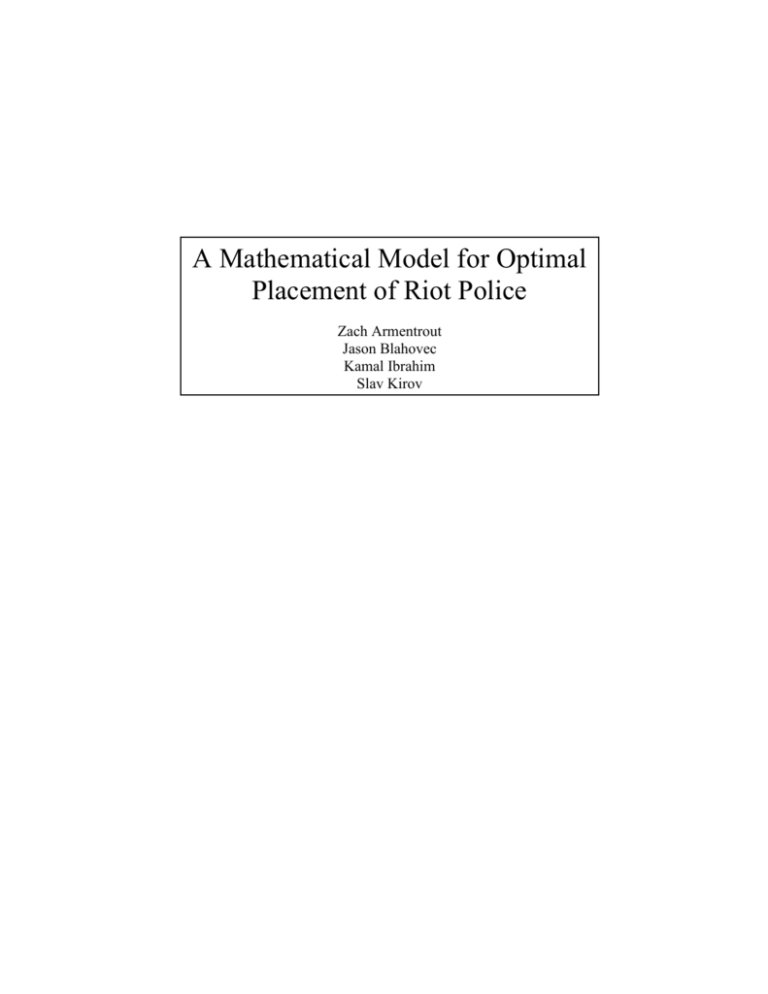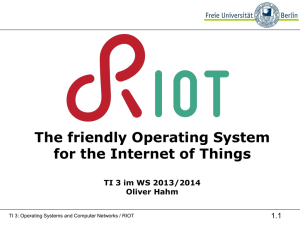The estimation of Maximum Damage Coefficients presented
advertisement

A Mathematical Model for Optimal
Placement of Riot Police
Zach Armentrout
Jason Blahovec
Kamal Ibrahim
Slav Kirov
Problem Overview
Well-populated cities are more likely to experience civil disobedience—
especially when it comes to two of humankind’s most galvanizing subjects:
politics and sports. Pittsburgh, Pennsylvania has been a prime example in recent
years. The Pittsburgh Steelers have won two of the last four Super Bowls,
inspiring several celebratory riots. The Pittsburgh Penguins’ Stanley Cup victory
in June, 2009 gave way to similar mayhem. And in September, 2009, an
estimated 4,500 protestors swarmed the city to demonstrate around the G-20
Pittsburgh summit, requiring at least 2,000 police offers to control; still, the affair
resulted in approximately $50,000 worth of damage to local businesses. One
cannot help but wonder if police could have more effectively thwarted these
inevitable vandalism attempts by reorganizing themselves. Hence, the problem of
optimal placement of police in preparation for a riot in Pittsburgh is worthy of
exploration.
Approach
First, a definition of “optimal police placement” became necessary.
Assuming that one or more riots are very likely to occur within an area of interest,
an optimal placement of police is defined as that which would minimize the total
expected damage over that area. It is assumed in this model that a riot will remain
stationary and inflict damage only at its point of origin. The following steps
outline the approach to the problem:
1.
Draw boundaries: The Oakland neighborhood in Pittsburgh has
incurred significant damage during the city’s most recent riots.
Thus, the model outlined in this report will consider only this
area. Thirty points within the neighborhood were selected as
potential riot locations. Riots were assumed to only inflict
damage at these locations. The optimal solution would, in the
likelihood of a riot, call for a specific, non-negative number of
police at each of these points. The damage at a point is
inversely correlated with the number of police assigned there.
2.
Determine the probability of a riot: To find the expected
damage at a potential riot location, the probability of a riot
breaking out at a given point must be known. Hence a
distribution of riot probabilities must be defined.
3.
Assignment of Maximum-Damage Coefficients (MDCs): The
MDC is a constant assigned to a given potential riot location
that defines the damage at said location given that a riot will
occur there with 100% probability and that there are zero police
assigned there. Thus, at each location, if the probability of a
riot decreases (from 1.0), or the number of assigned police
increases (from zero), the expected damage will decrease.
4.
Find an optimal assignment: Using integer programming, find
the placement of police that minimizes the expected damage
over the entire area considered. The integer program is subject
to a budget constraint that defines the maximum number of
police available to the area.
Objective Function
The objective function measures the total expected damage over the
Oakland area. For potential riot location , the objective function contains the
following components:
-
Maximum-Damage Coefficient
Probability of a riot
Variable number of police assigned
The total expected damage
potential riot location:
is equal to the sum of the expected damage at each
Constraints
The optimal solution is constrained by the following:
Considering that the Pittsburgh Bureau of Police employs an estimated 1,000
officers, and that the Oakland neighborhood covers approximately 1.29 square
kilometers, a value of 100 was chosen for .
The Probability Factor
Background
Riots are known to happen in places that are more populated. An accurate
way to gauge the likelihood of a riot in an area is to determine the area’s
population density. Once the population densities for an area have been obtained,
a probability-generating function is necessary—one that will take in an x
coordinate as a parameter. The probability will allow for the determination of
whether or not a riot will occur at a given location.
The population of the Oakland area is normally distributed with a mean of
2,174 people per km2 and a standard deviation of 758 people per km2 (“Oakland,
Pennsylvania profile”).
Effective Riot Multiplier
The expected population for an effective riot is the average amount of
people residing in an area for an effective riot to take place (Dippity). However,
it is contingent upon the location itself. To estimate a population for an effective
riot for each location it is necessary to take the expected population and divide it
by the median point. Essentially, the average population size of heavily rioted
areas was divided by 65, the median x coordinate (the map used will be shown
below), which yielded 45.768. This constant multiplied with an x coordinate
should give the estimated population for an effective riot in the area represented
by that coordinate.
Probability
The distribution then estimates the probability that the estimated
population is the population for that area.
Data
Mean
2174
x coord.
34
40
42
46
46
49
50
54
55
51
59
59
63
62
61
65
66
70
66
72
74
76
80
81
86
86
80
94
St.dev
758
Z value
-0.81516
-0.45288
-0.33212
-0.0906
-0.0906
0.090544
0.150923
0.392443
0.452823
0.211303
0.694343
0.694343
0.935863
0.875483
0.815103
1.056623
1.117003
1.358522
1.117003
1.479282
1.600042
1.720802
1.962322
2.022702
2.324602
2.324602
1.962322
2.807641
Probability
0.207492
0.325319
0.369901
0.463907
0.463907
0.536072
0.559982
0.652635
0.674662
0.583675
0.756266
0.756266
0.825328
0.809344
0.792493
0.854658
0.868003
0.912851
0.868003
0.930468
0.945205
0.957357
0.975137
0.978448
0.989953
0.989953
0.975137
0.997505
Maximum-Damage Coefficients (MDC’s)
The estimation of Maximum-Damage Coefficients (MDCs) presented
numerous challenges. These challenges included what damage units to use and
how to evaluate expected damage at a large number of potential riot locations.
The following discusses how these problems were dealt with and outlines the
method used in assigning MDCs.
Recall from earlier
“The MDC is a constant assigned to a given potential riot location that
defines the damage at said location given that a riot will occur there
with 100% probability and that there are zero police assigned there.
Thus, at each location, if the probability of a riot decreases (from 1.0),
or the number of assigned police increases (from zero), the expected
damage will decrease.”
Area Selection
Area selection presented the first challenge. The area taken into
consideration was restricted to the Oakland neighborhood. The reason for this
selection is primarily for simplicity, but also creates a better situation for damage
estimation (more on this will be explained later). The specific boundaries of the
area under consideration are Craft Avenue to the west, Morewood Avenue to the
east, Center Avenue to the north, and Bates Street to the south. The proposed area
is outlined by heavy black lines in the map shown below.
Damage Estimation
The next consideration was how to estimate the damage at numerous
potential riot locations. Ideally, independent assignment of MDCs would be
made at a large number of potential riot locations. Unfortunately, this becomes
quite expensive, especially when considering a potential police location on every
intersection in Oakland (a more ideal goal).
Because computational cost is an important aspect of the process, and
independent assignment of MDCs had already been ruled out due to its high cost,
a new estimation technique became necessary. The new technique needed to be
cheap but able to evaluate damage at any potential riot location. It became
obvious that damage evaluation at a few key points and interpolation to potential
riot locations was more optimal in terms of cost efficiency.
The key points at which MDC assessments are necessary (called
“landmarks”) were chosen based on cultural or economic significance. While the
landmarks themselves were not considered potential riot locations (the set of
landmarks and set of potential riot locations were defined to be disjoint), each
would have an effect on the assignment of the MDC at a potential riot location.
Determining a realistic relationship between distance from a landmark and
expected damage incurred became the next issue.
Considering how a typical riot plays out, it can be assumed that rioters will
protest near a landmark, and that damage around a landmark will decrease as
distance from a landmark increases. Exponential and linear decay were
considered reasonable options for the modeling of this phenomenon. However,
the assumptions under exponential decay were more appropriate for modeling riot
damage. Linear decay would give negative contributions to a MDC for large
distances from a landmark, whereas exponential decay will yield positive results,
eventually becoming negligible at large distances. Under exponential decay, each
landmark requires an initial value (the MDC at the landmark), and a rate of decay.
A small rate of decay is chosen to represent a widespread riot (as with the Super
Bowl Riots on the University of Pittsburgh campus). A large rate of decay
signifies a localized riot (as with the riots outside Phipps conservatory during the
G-20).
As stated before, MDCs are to be assessed at a small number of landmarks
throughout Oakland. The contribution of each landmark to the MDC at each
potential riot location is then calculated using exponential decay as described
above. Next, the MDC at a given potential riot location is defined as the sum of
the contributions from each landmark on that potential riot location
The landmarks used in the model considered for this report are shown in
the chart below.
Landmark
Rate of Decay
Peterson Events Center
1
UPMC Presbyterian
1
The Original Hot Dog Shoppe
5
Soldiers and Sailors Hall
5
Cathedral of Learning
.1
Carnegie Museum
.5
Phipps Conservatory
10
Pittsburgh Central Catholic H.S.
4
*Note: these rates of decay are based on events that occurred during the
Super Bowl XLIII and G-20 riots
The final map used in this report is shown below. It includes thirty police
points (denoted by black squares). The landmarks are denoted by blue targets.
The red lines show the coordinate axis used in calculating distances from police
points to landmarks.
Solving for Optimal Placement
To solve for the optimal placement of police the Branch and Bound algorithm in
MATLAB was implemented. The algorithm first solves the “relaxed” problem (RP), for
which the optimal Xi is a non-negative real number i n and where n 1,2,...,n,
with the use of a nonlinear optimization function in MATLAB, FMINCON. The
algorithm then branches on the first optimal non-integer Xi and bounds using the current
best integer solution.
Solving Relaxed Nonlinear Problem using FMINCON
In order to solve the RP, the FMINCON function in MATLAB was used. FMINCON
uses an Active-Set algorithm to find the minimum of a function subject to several
constraints. It is important to note that FMINCON also uses function and constraint
tolerances to determine when to stop, so the solution it returns may not be exact, but
approximate.
Branch & Bound Algorithm
The Branch and Bound (B&B) Algorithm solves the optimal placement problem by doing
the following:
1. Track a current best integer solution (currAssign) and function value (currOpt).
At the start, this is done by setting X1=X2=…=Xn=0 so that
currOpt =
n
i1
pi di .
2. Solve the RP using FMINCON, returning function value rpOpt.
If rpOpt ≥ currOpt then skip steps 3 and 4.
3. Letb = min{i [n] | Xi is not an integer} and let
RP1: RP with additional constraint X i X i
RP2: RP with additional constraint X i X i
4. Repeat steps 1-4 for RP1 and then for RP2.
In essence, one can assume that FMINCON
returns the exact optimum, then B&B will
solve the optimal placement problem by exploring all feasible and worthwhile cases for
the solution.
Results and Analysis
Several results to the optimal placement problem were obtained. The results differ
in the methods and tolerances used. To obtain a rough idea of the optimal placement,
solutions to the RP were found using both the FMINCON function and the method of
Lagrange multipliers. For FMINCON, several function and constraint tolerances were
tested, all of which strangely produced different nearly integer solutions. In the table
below, only the results from the lowest tolerance (E-100) are shown. This motivated a
calculation of the exact optimum using the method of Lagrange multipliers for which the
restriction on Xi being non-negative i n was eased (note X1 <0 below). The drastic
differences of the solutions and their values below suggest that the Active-set algorithm
is neither accurate nor efficient when given a highly unconstrained problem. This is
justified by observing the results from the branch and bound function that return solutions
despite given larger tolerances (E-20, E-30).
with a smaller expected damage
X coordinate
Optimal Non-integer Placement
Optimal Placement
Method
34
40
42
46
46
49
50
54
55
51
59
59
63
62
61
65
66
70
66
72
74
76
80
81
86
86
80
94
94
89
Lagrange
-0.2718
0.3160
0.4595
1.2821
0.7969
1.0558
1.6209
2.1143
1.9453
1.1339
3.8586
3.4824
5.0967
3.9512
2.7876
5.2875
4.3698
7.9449
5.0939
7.5173
4.1697
6.0529
6.0943
4.8660
5.3430
3.7018
2.9775
3.1695
2.3145
2.4682
FMINCON
0
0
0
0
0
0
0
0
0
0
0
0
0
0
0
0
0
25
0
50
0
0
0
0
25
0
0
0
0
0
Expected Damage
1.01E+06
4.01E+06
3.10E+06
1.35E+06
E-100
E-20
E-30
1596.9
19648.82
Tolerances
CPU Time (s)
Branch and Bound
0
0
0
0
0
0
0
1
0
0
0
1
0
2
0
4
0
3
0
5
0
4
0
4
2
4
0
4
0
4
27
0
0
2
2
6
9
4
4
4
0
4
27
4
29
6
0
4
0
8
0
4
0
5
0
5
0
4
0
4
Improvements to the Model
The following are improvements to the model that are worth implementing:
1. Consider a significantly larger set of potential riot locations that spans a larger
area.
A greater number of potential riot locations would allow more accurate
placement of police within the confines of the model. Widening the area to which
the model applies (e.g., to the entire city of Pittsburgh) would simply make the
results more valuable.
2. Improve the validity of the Maximum-Damage Coefficients and the riot
probability distribution.
The current distribution makes too strong an assumption—that the
probability of a riot depends only on Oakland’s population densities as they relate
to an east- west horizontal axis. An improved probability distribution would take
into account a potential riot location’s position on the vertical axis in addition to
its horizontal coordinate.
While convenient, the assumptions used in the determination of
Maximum-Damage Coefficients are very strong. Interpolating MDCs based on
those of landmarks, as the method dictates now, discounts the inherent value of
the potential riot locations themselves. Realistically, one cannot assume that the
“value” of a location depends solely on its proximity to a site of cultural or
economical significance. A better, but less cost-effective alternative is to
independently assess the expected damage at each potential riot location assuming
a constant riot size and no police protection. Additionally, the landmarks should
be added to the set of potential riot locations—the current model uses them only
to determine MDCs.
3. Employ a more realistic objective function.
Assuming that the improved model incorporates a much larger set of
potential riot locations, police “assistance” is a reasonable assumption. That is,
one can assume police are mobile and can assist the police at adjacent potential
riot locations. Thus, the expected damage at any potential riot location would be
reduced by the number of police at all adjacent locations. (“Adjacent” here is
defined as one distance unit away along the horizontal or vertical axis.) The
following objective function incorporates this assumption:
represents an indicator function. Define P as the set of all potential riot
locations, this time defined by all feasible (x,y) pairs within a square area. Also,
superimpose the first quadrant of the Cartesian coordinate system onto the target
area, where n is the maximum x and y coordinate.
Works Referenced
Briem, Christopher. City of Pittsburgh Population Density by Census Block - 2000. 2000. Raw
data. University of Pittsburgh University Center for Social and Urban Research,
Pittsburgh, PA.
"Oakland, Pennsylvania (PA 16101) profile: population, maps, real estate, averages, homes,
statistics, relocation, travel, jobs, hospitals, schools, crime, moving, houses, sex
offenders, news." Stats about all US cities. Web. 11 Nov. 2009. <http://www.citydata.com/city/Oakland-Pennsylvania.html>.
"Pittsburgh Riots." Dipity. Web. Fall 2009. <http://www.dipity.com/timeline/Pittsburgh-Riots>.
"Pittsburgh Riots." Google News Timeline. Web. 11 Nov. 2009.
<http://newstimeline.googlelabs.com/>.








